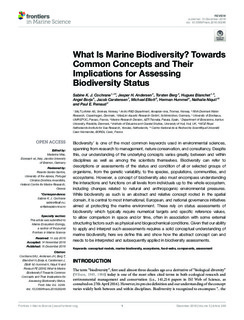| dc.contributor.author | Cochrane, Sabine K.J. | |
| dc.contributor.author | Andersen, Jesper H | |
| dc.contributor.author | Berg, Torsten | |
| dc.contributor.author | Blanchet, Hugues | |
| dc.contributor.author | Borja, Ángel | |
| dc.contributor.author | Carstensen, Jacob | |
| dc.contributor.author | Elliott, Michael | |
| dc.contributor.author | Hummel, Herman | |
| dc.contributor.author | Niquil, Nathalie | |
| dc.contributor.author | Renaud, Paul E | |
| dc.date.accessioned | 2018-08-01T11:11:05Z | |
| dc.date.available | 2018-08-01T11:11:05Z | |
| dc.date.created | 2017-02-04T15:59:50Z | |
| dc.date.issued | 2016 | |
| dc.identifier.citation | Frontiers in Marine Science. 2016, 3:248 . | nb_NO |
| dc.identifier.issn | 2296-7745 | |
| dc.identifier.uri | http://hdl.handle.net/11250/2507106 | |
| dc.description.abstract | Biodiversity’ is one of the most common keywords used in environmental sciences, spanning from research to management, natureconservation, and consultancy. Despite this, our understanding of the underlying concepts varies greatly, between and within disciplines as well as among the scientists themselves. Biodiversity can refer to descriptions or assessments of the status and condition of all or selected groups of organisms, from the genetic variability, to the species, populations, communities, and ecosystems. However, a concept of biodiversity also must encompass understanding the interactions and functions on all levels from individuals up to the whole ecosystem, including changes related to natural and anthropogenic environmental pressures. While biodiversity as such is an abstract and relative concept rooted in the spatial domain, it is central to most international, European, and national governance initiatives aimed at protecting the marine environment. These rely on status assessments of biodiversity which typically require numerical targets and specific reference values, to allow comparison in space and/or time, often in association with some external structuring factors such as physical and biogeochemical conditions. Given that our ability to apply and interpret such assessments requires a solid conceptual understanding of marine biodiversity, here we define this and show how the abstract concept can and needs to be interpreted and subsequently applied in biodiversity assessments. | nb_NO |
| dc.language.iso | eng | nb_NO |
| dc.publisher | Frontiers Media | nb_NO |
| dc.rights | Navngivelse 4.0 Internasjonal | * |
| dc.rights.uri | http://creativecommons.org/licenses/by/4.0/deed.no | * |
| dc.title | What Is Marine Biodiversity? Towards Common Concepts and Their Implications for Assessing Biodiversity Status | nb_NO |
| dc.type | Journal article | nb_NO |
| dc.type | Peer reviewed | nb_NO |
| dc.description.version | publishedVersion | nb_NO |
| dc.rights.holder | Copyright © 2016 Cochrane, Andersen, Berg, Blanchet, Borja, Carstensen, Elliott, Hummel, Niquil and Renaud. | nb_NO |
| dc.source.pagenumber | 14 | nb_NO |
| dc.source.volume | 3:248 | nb_NO |
| dc.source.journal | Frontiers in Marine Science | nb_NO |
| dc.identifier.doi | 10.3389/fmars.2016.00248 | |
| dc.identifier.cristin | 1447009 | |
| dc.relation.project | EC/FP7/308392 | nb_NO |
| cristin.unitcode | 7464,60,0,0 | |
| cristin.unitname | NIVA Danmark | |
| cristin.ispublished | true | |
| cristin.fulltext | original | |
| cristin.qualitycode | 1 | |

